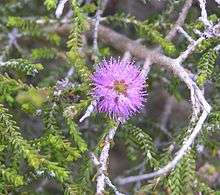Beaufortia empetrifolia
Beaufortia empetrifolia, commonly known as south coast beaufortia, is a plant in the myrtle family, Myrtaceae and is endemic to the south-west of Western Australia. It is a highly branched shrub with small, crowded leaves and pinkish to purple flowers in small, bottlebrush-like spikes in the warmer months. It is similar to Beaufortia micrantha except that its leaves are slightly larger.
| South coast beaufortia | |
|---|---|
 | |
| Scientific classification | |
| Kingdom: | Plantae |
| Clade: | Tracheophytes |
| Clade: | Angiosperms |
| Clade: | Eudicots |
| Clade: | Rosids |
| Order: | Myrtales |
| Family: | Myrtaceae |
| Genus: | Beaufortia |
| Species: | B. empetrifolia |
| Binomial name | |
| Beaufortia empetrifolia | |
| Synonyms | |
|
Melaleuca empetrifolia Rchb. | |
Description
Beaufortia empetrifolia is a compact, much branched shrub which grows to a height of 2 m (7 ft). The leaves are arranged in opposite pairs (decussate) so they make four rows along the stems. The leaves are egg-shaped, 1.5–3 mm (0.06–0.1 in) long and 0.5–2 mm (0.02–0.08 in) wide.[1][2][3][4]
The flowers are pink to purplish red and are arranged in heads about 20 mm (0.8 in) in diameter, on the ends of branches which continue to grow after flowering. The flowers have 5 sepals, 5 petals and 5 bundles of stamens with usually three to five stamens each. The stamens bundles are hairy and joined for 1.5–5 mm (0.06–0.2 in) of their length with the free parts a further 2.5–5 mm (0.1–0.2 in) long. Flowering can occur in almost any month, depending on the weather and is followed by fruits which are woody capsules. The capsules are 6.5–11.5 mm (0.3–0.5 in) long and 5–6 mm (0.20–0.24 in) wide and often joined together.[1][2]
Taxonomy and naming
Melaleuca empetrifolia was first formally described in 1828 by the German botanist, Ludwig Reichenbach in Iconographia Botanica Exotica.[5] In 1843, Johannes Schauer recognised it as Beaufortia empetrifolia.[6] Lyndley Craven proposes combining Beaufortia and several other related genera with Melaleuca,[7] in which case, Reichenbach's original name would be restored.
Distribution and habitat
Beaufortia empetrifolia mainly occurs in and between the Albany and Esperance districts in the Esperance Plains, Hampton, Jarrah Forest and Mallee biogeographic regions.[2] It usually grows in sand, often near granite outcrops.[8]
Conservation
Beaufortia empetrifolia is classified as "not threatened" by the Western Australian Government Department of Parks and Wildlife.[2]
References
- Burbidge, Andrew A. (2016). "A taxonomic revision of Beaufortia (Myrtaceae: Melaleuceae)". Nuytsia. 27: 182–184.
- "Beaufortia empetrifolia". FloraBase. Retrieved 21 August 2015.
- Archer, William. "Beaufortia micrantha var. micrantha – Small Bottlebrush". Esperance Wildflowers. Retrieved 20 August 2015.
- Bentham, George; von Mueller, Ferdinand (1866). Flora Australiensis (Volume III). London: Lovell Reeve and Co. p. 167. Retrieved 21 August 2015.
- "Melaleuca empetrifolia". APNI. Retrieved 21 August 2015.
- "Beaufortia empetrifolia". APNI. Retrieved 21 August 2015.
- Craven, Lyn A.; Edwards, Robert D.; Cowley, Kirsten J. (30 June 2014). "New combinations and names in Melaleuca (Myrtaceae)". Taxon. 63 (3): 663–670. doi:10.12705/633.38.
- Paczkowska, Grazyna; Chapman, Alex R. (2000). The Western Australian flora : a descriptive catalogue. Perth: Wildflower Society of Western Australia. p. 349. ISBN 0646402439.